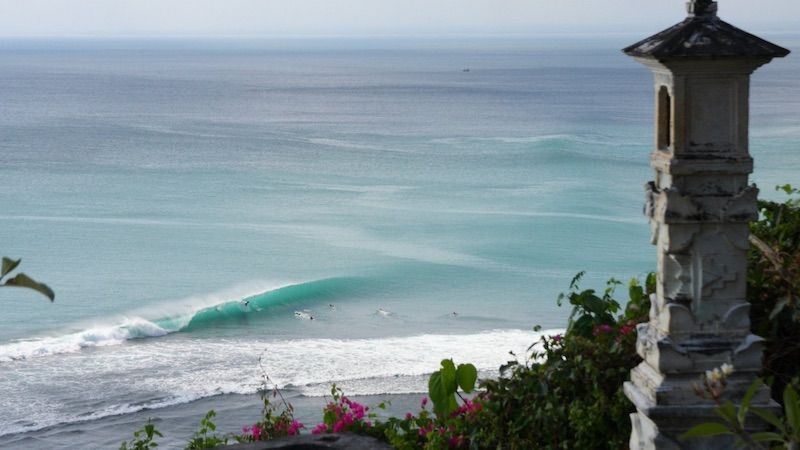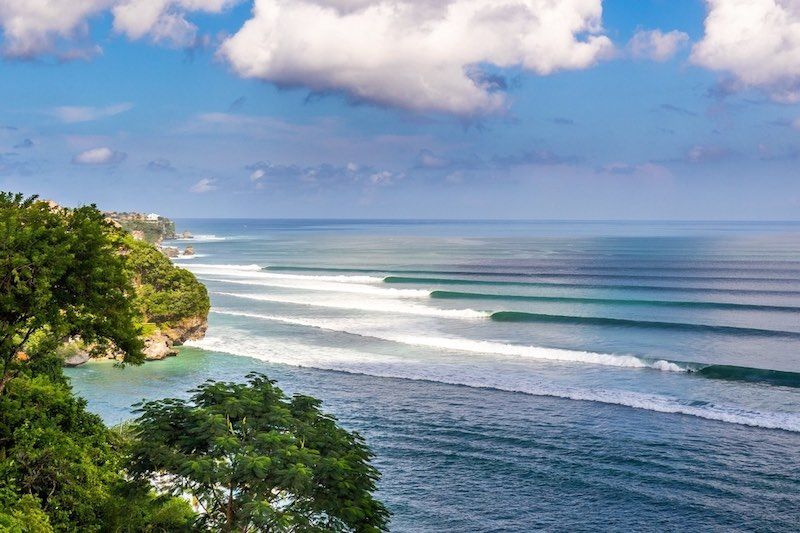
Bingin. Photo: Guff
COASTALWATCH | TRAVEL
Story by Matt Rode
The Surprising Story of a Hollywood Legend’s Wife and an American Tennis Coach
Over the years, Bali has become the quintessential Australian surfing destination—a short flight from the continent, and full of epic, tropical waves, all hosted by some of the friendliest and most culturally rich people on the planet. In addition to Aus, surfers from just about every other region around the globe travel to Bali each year, either as a starting point for trips to other famed Indonesian zones such as the Mentawais, Lombok, and Sumbawa, or simply to surf the classic reef points of the Bukit Peninsula.
Alongside Oahu, Southern California, and Australia’s Gold Coast, Bali is one of the epicentres of both the surf industry and surf lifestyle—and has been for decades.
Some people assume that the first surfing done on Bali was during the sessions captured in Albe Falzon’s classic Morning of the Earth. But while Falzon’s footage of Stephen Cooney and Rusty Miller’s shredding the walls of Uluwatu on their late 1960s single-fins was almost certainly the catalyst for the modern surf scene on Bali—and arguably for the entire tourism industry there, now valued at tens of billions of dollars annually—the first documented surf session on the “Island of the Gods” occurred more than three decades earlier.
In 1936, American Bob Koke arrived on Bali with a woman named Louise, who he claimed was his wife. As it turns out, Louise was the estranged wife of Oliver H.P. Garrett, a Hollywood screenwriter with blockbuster credits such as A Farewell to Arms and Duel in the Sun to his name. Louise was fed up with her husband’s notorious string of affairs and had decided to have one of her own, shacking up and then shipping out with Koke, a tennis coach who had spent time at Garrett’s home in Beverly Hills.
Bob and Louise Koke—who did eventually marry—found their way to Bali, where they soon met eccentric British expat Muriel Pearsen. Pearsen had been living in Bali for some time, and had adopted the local name “K’tut Tantri”. Tantri and the soon Kokes decided to go into business together, and ended up opening Kuta Beach Hotel—the first hotel of its kind on the south coast of Bali, and the beginning of what would one day become a booming Bali resort industry.
Bob Koke had picked up surfing in Hawaii during an MGM film shoot in 1932, and he liked what he saw as he watched the gentle rollers in front of their hotel on Kuta Beach. He had his redwood plank shipped over from Hawaii, and in the meantime shaped a handful of alaias out of local wood, with the intention of teaching surfing to hotel guests.
When Koke’s large redwood board arrived, his local staff struggled to control it in the waves. But they quickly picked up surfing on alaias, and were soon giving lessons to the tourists at the Kuta Beach Hotel—effectively pioneering the Indonesian surf industry 35 years before it officially became a thing.

Impossibles: Danny Bastiaanse
During World War II, with the Japanese set to invade Indonesia, the Kokes decided to leave Bali. Louise returned to California, while Bob joined the US Army, and eventually the CIA. Their hotel was burned down during their absence, and aside from the presence of Koke’s original surfboards, the surf scene on the island lay relatively dormant until the late 1960s, when Australians “discovered” the surf potential on Kuta Beach.
By then, the shortboard revolution was in full effect, and it was only a matter of time before the world’s best wave riders discovered and documented the more advanced waves of the Bukit Peninsula. Upon the release of Morning of the Earth, Bali immediately became the latest en vogue surf destination, and within a couple of years thousands of foreign surfers began flocking to the island.
Koke revisited Bali for the last time in 1993, after the death of his wife Louise. His redwood plank and locally shaped alaias are still on the island today.
–
This article also appeared on Magic Seaweed
Please enable JavaScript to view the comments powered by Disqus.





Recent Comments